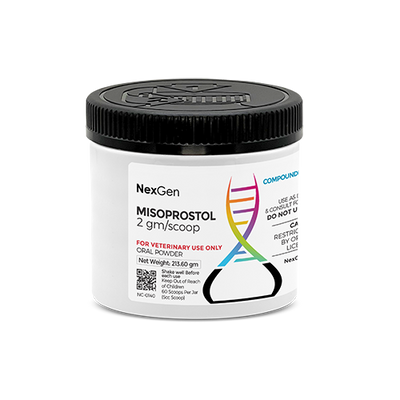
Omeprazole 2.2 gm/scoop + Misoprostol 1.4 mg/scoop, Oral Powder, 120 Scoops (9cc Scoop)
Login for pricing
- Brand
- Mixlab
- SKU:
- NC-0095
- Product Type:
- Powder
- Size:
- 64oz
- Administration:
- Oral
- Scoops Per Container:
- 120
- Scoop Size:
- 9cc
Working horses often suffer from a disorder of the larynx called arytenoid chondritis or inflammation of the arytenoid cartilages. The arytenoid cartilages make up an important part of the larynx, which is located at the end of the nasal passages near the trachea.1 This can lead to shortness of breath and an inability to perform. Obviously, any condition that affects a horse’s respiratory tract has the potential to negatively impact performance. This would include conditions such as arytenoid chondritis and gastroesophageal reflux disease (GERD).
In one study, researchers used six horses treated with either 1 mg/kg or 4 mg/kg of omeprazole while receiving either a high-grain/low-fiber diet or a diet comprised of free-choice hay. The “area under the curve” (AUC), which is a measure of how much of the body is exposed to the drug after administration, was higher in horses treated with 4 mg/kg rather than 1 mg/kg of omeprazole. Although the AUC was higher in horses treated with omeprazole and fed a high-grain/low-fiber diet rather than hay, the difference between the two groups was not statistically significant. Further, there was a great deal of variability observed in the AUCs in the high-grain/low-fiber diet, suggesting that perhaps even though absorption of omeprazole in horses fed hay is lower than the high-grain/low-fiber diet, the absorption is more predictable and therefore desirable.3
Omeprazole: Pharmacology & Pharmacokinetics
Pharmacokinetically, omeprazole’s effects on acid secretion are independent of its drug levels. Omeprazole is rapidly absorbed from the gut; the human commercial product is in an enteric-coated granule form, as the drug is rapidly degraded by acid. Food reduces omeprazole absorption on horse by as much as 67%.3
Oral paste products containing omeprazole are labeled for use in horses and foals 4 weeks of age and older. The drug effectively treats4,5 and prevents6,7 gastric ulcers, and is considered the drug of choice of equine gastric ulcer syndrome.8 Ulcer healing and improvement was much better when omeprazole was used for squamous gastric ulcers than glandular gastric ulcers.9,10 For the prevention of gastric ulcers and/or ongoing treatment however, these medications are more often used in powdered form in the horse’s feed.
Misoprostol
Misoprostol has two main pharmacologic effects that make it a potentially useful agent. By a direct action on parietal cells, it inhibits basal and nocturnal gastric acid secretion as well as gastric acid secretions that are stimulated by food, pentagastrin, or histamine.1
Omeprazole+ Misoprostol in paste form is generally used to treat acute gastric issues in equines; for the prevention of gastric ulcers and/or ongoing treatment, these medications are more often used in powdered form, whereby they may be administered in the horse’s feed.
Dosages
One study found that dosages as low as 0.5 mg/kg PO every 24 hours (extra-label) were as effective as the higher dose.13
Foals: Treatment or prophylaxis of gastric ulcers (extra-label): Treatment: Omeprazole 4 mg/kg PO every 24 hours. Prophylaxis: 1 – 2 mg/kg PO every 24 hours for prophylaxis.14
Where to buy Omeprazole+Misoprostol
Omeprazole+Misoprostol is available in the U.S. through several pharmaceutical manufacturers and through veterinary custom compounding companies.
FOR RX ONLY: A valid prescription from a licensed veterinarian is required for dispensing this medication.
3EquiNews.
4Bush J, van den Boom R, Franklin S. Comparison of aloe vera and omeprazole in the treatment of equine gastric ulcer syndrome. Equine Veterinary Journal. 2018;50(1):34-40.
5Kerbyson NC, Knottenbelt DK, Carslake HB, Conwell RC, Sutton DGM, Parkin TDH. A Comparison Between Omeprazole and a Dietary Supplement for the Management of Squamous Gastric Ulceration in Horses. Journal of Equine Veterinary Science. 2016;40:94-101.
6Mason LV, Moroney JR, Mason RJ. Prophylactic therapy with omeprazole for prevention of equine gastric ulcer syndrome (EGUS) in horses in active training: A meta-analysis. Equine Veterinary Journal. 2019;51(1):11-19.
7Endo Y, Tsuchiya T, Sato F, et al. Efficacy of omeprazole paste in the prevention of gastric ulcers in 2 years old thoroughbreds. J Vet Med Sci. 2012;74(8):1079-1081.
8Sykes BW, Hewetson M, Hepburn RJ, Luthersson N, Tamzali Y. European College of Equine Internal Medicine Consensus Statement-Equine Gastric Ulcer Syndrome in Adult Horses. J Vet Intern Med. 2015;29(5):1288-1299.
9Sykes BW, Sykes KM, Hallowell GD. A comparison of three doses of omeprazole in the treatment of gastric ulceration in throughbred racehorses. J Vet Intern Med. 2013;27(3):652-652.
10Sykes BW, Sykes K, Hallowell GD. Comparison of the effect of two doses of omeprazole on the squamous gastric mucosa in thoroughbred racehorses. Vet Rec. 2014;175(10).
11Lupi MP, Passini S, Montoya L, Albarellos G. Influence of the administration of omeprazole on the oral absorption of cephalexin: differences between adults and aged dogs. J Vet Pharmacol Ther. 2015;38:100-100.
12Thames BE, Lovvorn J, Papich MG, et al. The effects of clopidogrel and omeprazole on platelet function in normal dogs. J Vet Pharmacol Ther. 2017;40(2):130-139.
13Sykes BW, Sykes K, Hallowell GD. Comparison of the effect of two doses of omeprazole on the squamous gastric mucosa in thoroughbred racehorses. Vet Rec. 2014;175(10).
14Wilkins P. Disorders of foals. In: Reed S, Bayly W, Sellon D, eds. Equine Internal Medicine. 2nd ed. Philadelphia, PA: Saunders; 2004:1381-1431.















